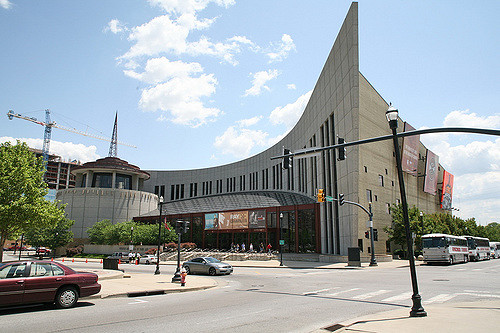Behind-the-Scenes: An Unexpected Nonprofit
Posted on April 11, 2016, at 5:40 p.m.
by Morgan Martin.
The word “nonprofit” often grinds people’s gears. Individuals hear this word, and they visualize streets covered in unused fliers, letters concerning donations filling up their mailboxes and hitting the red button on their iPhones when that certain number pops up once a year during fundraising season.
What people don’t visualize are the extravagant buildings that millions of individuals visit daily. These buildings provide centuries of history and endless entertainment for families. They may even house a venue for the best night of one’s life.
These nonprofit organizations are museums.
Hannah Van Der Stelt is the event services manager at the Country Music Hall of Fame and Museum in Nashville, Tennessee. Through her time as a museum employee, she has learned to appreciate the true value of working for and promoting a museum.
“I never envisioned myself working in a nonprofit setting,” Van Der Stelt said. “I took an internship here because of my love of Nashville, but throughout my internship, I began to learn why working for a nonprofit like a museum is so rewarding — you work with individuals who have a passion for their cause. The second a position opened up, I immediately jumped on it.”
In the recent economy, it’s no mystery that nonprofit businesses struggle to stay afloat due to what many individuals refer to as an unsustainable business model. Yet year after year, museums like the Country Music Hall of Fame and Museum and others such as the Metropolitan Museum of Art in New York City and the Newseum in Washington, D.C., continue to evolve and generate revenue.

Use the niche
“Nashville has been coined as the capital of country music,” Ally White laughed. “The Country Music Hall of Fame and Museum thrives here because it fits perfectly into the nearly religious fan base of country music.”
White, a Texas A&M graduate, spent her summer working as a client services and marketing intern for the museum, and learned a thing or two about nonprofit promotion.
“You really have to use your location as a tool,” White said. “People from around the world come to Nashville to experience the city’s rich history in the country music industry. I spent a significant amount of time surveying customers on things like their purpose for being there, what they enjoyed, what they didn’t enjoy, etc. There was not one person who went through the exhibits who was not a country music fan.”
Just as the Country Music Hall of Fame and Museum resides in Nashville, Tennessee, the Newseum resides in Washington, D.C., a place where recent graduates who majored in journalism flock to make a career for themselves.
Successful, well-known museums that withstand the test of time are located where they are continuously relevant. Issues arise when a museum’s audience is no longer there. If a museum is placed in an area where the museum’s focus is timeless, it will continue to thrive.
Use the venue
Museums across America are known for their unique, often beautiful architecture. Appealing architecture can be a key factor in not only attracting audiences but also serve as a space for individuals and businesses to rent out for events, such as weddings, receptions, conferences and galas.
“You have no idea how much money comes from renting out our event spaces,” Van Der Stelt said. “The museum recently had a 210,000-square-foot expansion. Everyone was hesitant to invest in the expansion, but it has really given way to tons of opportunity.”
Museums have the unique ability to provide a captivating backdrop for any event. Individual museums provide different aesthetics from traditional to modern, from elegant to casual. Both the Country Music Hall of Fame and Museum and the Metropolitan Museum of Art use these event spaces to their advantage. If the public enjoys these events, why wouldn’t they want to come back to enjoy the exhibitions the museums have to offer as well?

Use the community
As previously noted, placing the museum where it is relevant is crucial. However, in order to create a dedicated audience, museums must cultivate distinct ways to keep the community in which the museums reside engaged.
In an interview with Nashville Business Journal, Kyle Young, CEO of the Country Music Hall of Fame and Museum, discussed different ways the museum successfully keeps the local community of Nashville coming back for more.
“The museum will continue to present more education and public programming as well as engage in more events and activities,” Young said. “In 2014, more than 150,000 visitors engaged in hands-on, educational activities developed in the Taylor Swift Education Center, Historic RCA Studio B and Hatch Show Print — from school tours, of which 90 percent of students are Tennesseans, to public programs and interactive activities that serve broader audiences. Good museums do great programs, and the Country Music Hall of Fame and Museum remains committed to providing meaningful and engaging programs to a wide audience while telling the evolving story of country music and its place in American culture.”
Use the roots
“It’s important to never underestimate the benefits that come from a well-done grassroots campaign,” White said. “Although Nashville is growing rapidly, it still has a very local feel. When we had events coming up last summer, we would take fliers to local businesses and spread the word via social media. The turnout was always great.”
Grassroots campaigns are always a go-to when one is trying to reach a local audience. Fliers, word-of-mouth and involving significant individuals within the community can only help.
“Like any nonprofit, the Country Music Hall of Fame and Museum uses its people both internally and externally,” Van Der Stelt said. “Tireless hours mean nothing when you’re working in a community that genuinely cares about a cause.”
It has been said that nonprofits are built to survive, not succeed. Museums prove that nonprofits can not only survive but also thrive in even the most adverse environments. Through the clutter of fliers, trashed envelopes and ignored phone calls, these organizations have found ways to evolve and continue to reach and engage their audiences.




